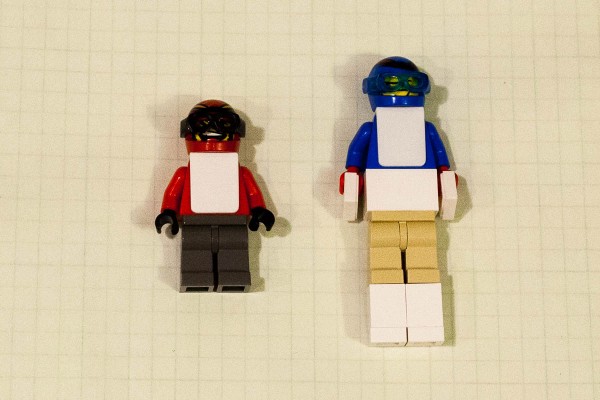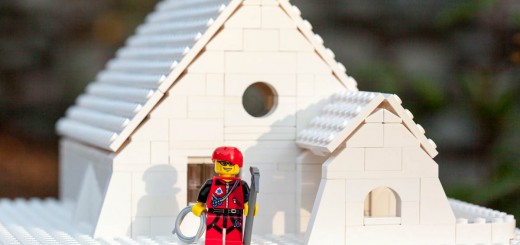Lego Challenge #19: Calculating Minifig Scale
This article may still be interesting since it looks at the process I used to measure the Classic LEGO minifigure, as well as a look at how to correct minfigure proportions within the LEGO system.
Detailed description of project
Yesterday’s project aimed to better understand the proportions of common Lego elements as well as the proportions within the brick design itself. For today’s project, I want to estimate “Minifig Scale” by measuring the proportions of a minifig and the average dimensions of a human. I will need to address the fact that minifigure proportions are not even close to those of an average adult human.
Step 1: Determine conversion factor
I measured a stack of 10 bricks as 3.8 inches, or 9.6 cm. As a precision and mathematical double-check, I also measured a 32×32 baseplate as 10.05 inches or 25.5 cm. Remembering that a brick is 5 Plastic wide (or “P”, my invented unit) and 6P tall, I can calculate the value of “P” in Inches and centimeters.
3.8 in / 10 bricks tall / 6P per brick tall = 0.0633 inches per "P"
10.05 in / 32 brick wide / 5P per stud tall = 0.0628 inches per "P"
As such, a single “P” is about 0.063 inches (0.16 centimeters).
Step 2: Measure a minifig
When you remove a standard minifigure’s hat/hair and any accessories between the torso and head, it is 4 bricks tall, which is 24P. (A hobbit or dwarf has shorter legs and is only 3 bricks + 1 plate tall, which is 20P.) A minifigure is 2 studs wide (10P) and 1 stud thick (5P). This yields a height / width / thickness ratio of 24 / 10 / 5 which reduces to about 5 / 2 / 1
By contrast the average Male adult in the US is 5′ 9.5″ (the average woman is 5′ 4″). Let’s use the adult male, as architectural models need to fit taller people than the average. Using a rough measurement of myself as an point of comparison, an adult male might have a “width” of around 18 inches and a thickness of around 9 inches. This yields a ratio of about 8 / 2 / 1.
So, a Minifigure has an comparable width to height ratio as an adult male, but the height is all messed up. This can be remedied in two ways, by modifying minfigures to have human proportions, or by using just the height of a minifigure to determine minifigure scale…
Step 3: “Minifig Scale”
Minifig scale for an anatomically modified minifig
Simple, if a normal minifigure is 24 “Plastics” tall, an anatomically adjusted minifigure would be 38 Plastic tall (or 6 bricks + 1 plate). Let’s go ahead and make an anatomically corrected minifigure to see how silly they look.
Well, it looks silly, but it gives you an idea of the approximate height of an anatomically corrected Minifigure. (I haven’t checked, but I expect that the new “Friends” minifigures designed for girls is closer to these proportions…)
anatomically correct minifigure = 38P tall* 0.063 Inch/P = 2.4 inches tall
scaling factor = 70 / 2.4 = 29:1 Ratio
Minifig scale for an anatomically modified minifig
As noted before, a normal minifig is 4 bricks or 24P tall. Let’s calculate minifigure scale based only on height.
normal minifigure = 24P tall * 0.063 Inch/P = 1.5 inches tall
scaling factor = 70 / 1.5 = 47:1 Ratio
Conclusion
As noted earlier, the approximate “Minifig” scaling factors were:
- 47:1 – Normal minifigure (based on height only.)
- 29:1 – Anatomically adjusted minifigure.
The main motivation behind this project was to determine an accurate estimate of Minifigure scale to use in latter projects. I was actually a bit surprised that the proportions of minifigures weren’t worse – everyone knows that Minifigures are way too wide. That said, my modified minifigure looks pretty silly, especially since the arms are way too short.
project time: 1 hour to measure bricks and minifigures, take the photos and do the calculations.









 TOM ALPHIN builds
TOM ALPHIN builds
I arrived at a scale of 1:43, based only on minifig height. However, I based my calculation on a global average human height of 1.7 metres, about 4% shorter than your value for an average American male.
I made this calculation in the context of determining how big a Lego Death Star would be at minifig scale: http://thedragonsmaw.blogspot.com.au/2012/09/how-big-should-lego-death-star-be.html
I spent some time trying to figure out a sensible scale for mf too. My conclusion was that the indiana jones type cars, (vintage cars and jeeps) with a one-piece dual seat were the best size. This gave me a scale based on a 6-stud wide car being equal to the width of a real car which is about 6 feet. 1 stud = 1′ or, as a ratio, 1:38.1 for an accurate conversion or 1:37.5 for a rounded 300mm foot aka fut.
As a bonus if you’re from UK or US it makes scaling really easy to go with 1 stud = 1′.
Another check is with the old school city wheel size which is just under 2 stud centres in diameter. Call it 15mm for clearance. 15 x 38 = 570mm. Now let’s take a typical tyre size eg 205/50-14 and that works out at 560mm diameter. pretty close.
no you average all human height for accuracy not one continent. thats not fair or accurate.
average man 5.6′ , average woman 5.2′ human average 5.4′ or 164.592cm
if a minifig is = 4cm. then a minifig accurately is 41.145 : 1 human scale.
i would find it interesting to scale up a brick to 41.145 x.. which would make a 1×2 brick 32.1 x 65.01 x 39.5cm
sounds pretty reasonable. but i cant print something that big.